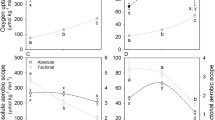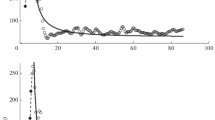Summary
-
1.
Physiological adaptation to hypothermia were studied in newly hatched great snipe chicks (Gallinago media) by measuring oxygen uptake (VO2), heart rate (HR), respiratory frequency (RF), and body temperature (Tb) at different ambient temperatures (Ta).
-
2.
Tb of 1-day-old chicks at Ta of 35°C stabilized at about 40°C. At Ta between 20 and 30°C the chicks maintained a Tb about 8°C above Ta. Hatchlings maintained a higher gradient when active than when resting. Below 20°C they were unable to maintain a stable Tb.
-
3.
In resting hatchlings VO2 was similar at Ta between 35 and 20°C (Tb 40–30°C), VO2 range 1.7–2.5 ml·g-1·h-1. Below 20°C, VO2 declined with time.
-
4.
The HR of 1-day-old chicks fell linearly with Tb during cooling. The Q10 of the HR was 1.7 at Tb 38°C and increased to 3.0 at 29°C. The RF showed a slight tendency to decrease with decreasing Tb.
-
5.
It is concluded that the ability to maintain normal dexterity at low Tb is an important aspect of snipe survival strategy. Maintaining a temperature gradient rather than a constant high Tb presumably saves energy. It is suggested that the mechanisms whereby VO2 is maintained at a low Tb may involve isoenzymes and adaptations of the nervous system. However, such adaptations would not seem to affect the pacemaker mechanism as evidenced by the high Q10 of the HR.
Similar content being viewed by others
Abbreviations
- HR :
-
heart rate
- RF :
-
respiratory frequency
- T a :
-
ambient temperature
- T b :
-
body temperature
- VO2 :
-
oxygen uptake
References
Ashkenazie S, Safriel N (1979) Time-energy budget of the semipalmated sandpiper Calidris pusilla at Barrow, Alaska. Ecology 60:783–799
Aulie A (1976) The pectoral muscle and development of thermoregulation in chicks of willow ptarmigan (Lagopus lagopus). Comp Biochem Physiol 53A:347–350
Aulie A, Moen P (1975) Metabolic thermoregulatory responses in eggs and chicks of willow ptarmigan (Lagopus lagopus). Comp Biochem Physiol 51A:605–609
Bech C, Martini S, Brent R, Rasmussen I (1984) Thermoregulation in newly hatched black-legged kittiwakes. Condor 86:339–341
Blix AS, Messelt EB, Grav HJ (1975) Differential effects of temperature on activity of LDH from seal and sheep skin. Acta Physiol Scand 95:77–82
Brunton DH (1988) Sexual differences in reproductive effort: time-activity budgets of monogamous killdeer, Charadrius vociferus. Anim Behav 36:705–717
Chatfield PO, Lyman CP, Irving L (1953) Temperature adaptations of nerves in the legs of gulls. Am J Physiol 172:639–644
Galbraith H (1988) Adaptation and constraint in the growth pattern of lapwing (Vanellus vanellus) chicks. J Zool 215:537–548
Grav HJ, Borch-Iohnsen B, Dahl HA, Gabrielsen GW, Steen JB (1988) Oxydative capacity of tissues contributing to thermogenesis in eider (Somateria mollissima) ducklings: changes associated with hatching. J Comp Physiol B 158:513–518
Hissa R, Saarela H, Rintamaki H, Linden H, Hohtola E (1983) Energetics and developement of temperature regulation in capercaillie (Terao urogallus). Physiol Zool 52:142–151
Koskimes J, Lahti L (1964) Cold-hardiness of the newly-hatched young in relation to ecology and distribution in ten species of European ducks. Auk 81:281–307
Lasiewski RC, Dawson WR (1967) A re-examination of the relation between standard metabolic rate and body weight in birds. Condor 69:13–23
Myhre K, Steen JB (1979) Body temperature and aspects of behavioural temperature regulation in some neonate subarctic and arctic birds. Ornis Scand 10:1–9
Norton DW (1973) Ecological energetics of calidrine sandpipers breeding in Northern Alaska. PhD thesis. Fairbanks: Univ of Alaska
Pedersen HC, Steen JB (1979) Behavioural thermoregulation in willow ptarmigan chicks (Lagopus lagopus). Ornis Scand 10:17–21
Purdy MA, Miller EH (1988) Time budget and parental behavior of breeding American black oystercatchers (Haematopus bachmani) in British Columbia. Can J Zool 66:1742–1751
Scholander PF (1949) Volumetric respirometer for aquatic animals. Rev Scient Instr 20:885–887
Steen JB, Gabrielsen GW (1988) The development of homcothermy in common eider ducklings (Somateria mollissima). Acta Physiol Scand 132:557–561
Steen JB, Krog JO, Tøyen Ø, Bretten S (1989) Poikilothermy and cold tolerance in young house martins (Delichon u. urbica) J Comp Physiol B 159:379–382
West GC, Norton DW (1975) Metabolic adaptations in tundra birds. In: Vernberg FJ (ed) Physiological adaptations to the environment. pp 301–329. Intext Educational Publications, New York
Author information
Authors and Affiliations
Rights and permissions
About this article
Cite this article
Steen, J.B., Tøien, Ø. & Fiske, P. Metabolic adaptations to hypothermia in snipe hatchings (Gallinago media). J Comp Physiol B 161, 155–158 (1991). https://doi.org/10.1007/BF00262878
Accepted:
Issue Date:
DOI: https://doi.org/10.1007/BF00262878




